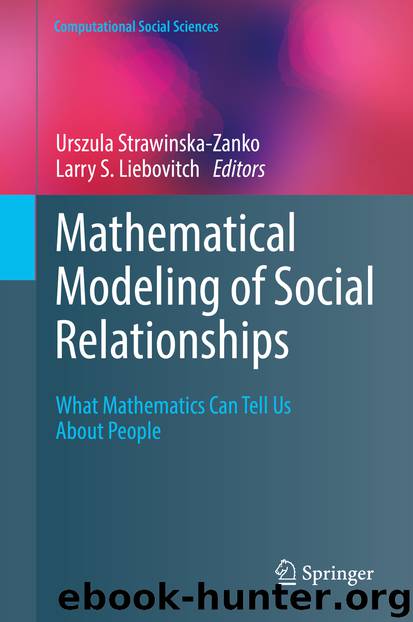Mathematical Modeling of Social Relationships by Urszula Strawinska-Zanko & Larry S. Liebovitch

Author:Urszula Strawinska-Zanko & Larry S. Liebovitch
Language: eng
Format: epub
Publisher: Springer International Publishing, Cham
6.4 Models as an Integrative Tool in Research
Cooperation and conflict are natural outcomes in societies populated by people who have individual differences, unique motives and backgrounds, and seek to achieve their goals in situations with inequalities and scarce resources. Both phenomena are inexorable components in the story of human civilization, perhaps tied to fundamental social evolution (Axelrod and Hamilton 1981; Nowak 2006). Cooperation is a foundation for social stability, and while some degree of conflict may be helpful for stimulating social change and evoking action, at a certain threshold it takes on a dark and destructive characteristic. The powerful sway that cooperation and conflict hold over human lives is reflected in these two forces prominently appearing in literature, art, and forms of expression that originate with the earliest known human civilizations. Despite cooperation and conflict having a certain centrality in life, how the two evolve over time and transition from one to the other remains poorly understood. Fortunately, new ways of thinking about cooperation and conflict are taking root in interdisciplinary social sciences and hold promise of advancing new discoveries and integrating fragmented, disciplinary isolated empirical and applied research.
Dynamic systems-inspired approaches to theory, research, and practice combined with mathematical models offer tools that may help better advance deep understanding of cooperation and conflict as processes. As Kenrick et al. (2009) concluded, “dynamical systems research holds the promise of understanding how the thoughts and motivations of individuals add up to monumental group level processes from civil rights marches to international conflicts” (p. 497). Trying to see such macro-level processes as they relate to the microlevel elements intrinsic within any single individual is quite difficult and is akin to “seeing the forest for the trees.” However, as illustrated with the two examples in this chapter, mathematical models are often helpful for understanding phenomena that may, on the surface, appear too complex to grasp from a rigorously scientific perspective. Cellular automata models help to reveal how basic principles of interaction between individual people (agents) translate to large-scale group organization. Such organization helps to understand how phenomena such as polarization and conflict might emerge in societies. Nonlinear differential equation-based models are useful for understanding how different variables intrinsic to individuals combine with different forms of social interaction to give rise to cooperation or conflict over time. Importantly, neither of these examples is superior to the other or to other approaches used in mathematical modeling. Instead, each modeling method brings with it unique strengths and weaknesses, affording insights into different domains of a complex world.
Mathematical models are further useful for interdisciplinary research in the sciences, where different disciplines and subfields share complex and dynamic relations in their own right. Mathematical models serve a central role in scientific inquiry as they are derived on parsimony, forcing researchers to specify exacting properties of the phenomenon of interest (Hunt 2007; Liebovitch et al. 2010; Nowak 2004). Furthermore, mathematics is a common language enabling models, developed upon premises unique to certain disciplines, to foster interdisciplinary collaborations. For example, a
Download
This site does not store any files on its server. We only index and link to content provided by other sites. Please contact the content providers to delete copyright contents if any and email us, we'll remove relevant links or contents immediately.
Algorithms of the Intelligent Web by Haralambos Marmanis;Dmitry Babenko(8519)
Azure Data and AI Architect Handbook by Olivier Mertens & Breght Van Baelen(7315)
Building Statistical Models in Python by Huy Hoang Nguyen & Paul N Adams & Stuart J Miller(7309)
Serverless Machine Learning with Amazon Redshift ML by Debu Panda & Phil Bates & Bhanu Pittampally & Sumeet Joshi(7195)
Data Wrangling on AWS by Navnit Shukla | Sankar M | Sam Palani(6956)
Driving Data Quality with Data Contracts by Andrew Jones(6943)
Machine Learning Model Serving Patterns and Best Practices by Md Johirul Islam(6680)
Learning SQL by Alan Beaulieu(6153)
Weapons of Math Destruction by Cathy O'Neil(6077)
Big Data Analysis with Python by Ivan Marin(5695)
Data Engineering with dbt by Roberto Zagni(4692)
Solidity Programming Essentials by Ritesh Modi(4355)
Time Series Analysis with Python Cookbook by Tarek A. Atwan(4188)
Pandas Cookbook by Theodore Petrou(3912)
Blockchain Basics by Daniel Drescher(3424)
Hands-On Machine Learning for Algorithmic Trading by Stefan Jansen(2960)
Natural Language Processing with Java Cookbook by Richard M. Reese(2919)
Feature Store for Machine Learning by Jayanth Kumar M J(2858)
Learn T-SQL Querying by Pam Lahoud & Pedro Lopes(2844)
